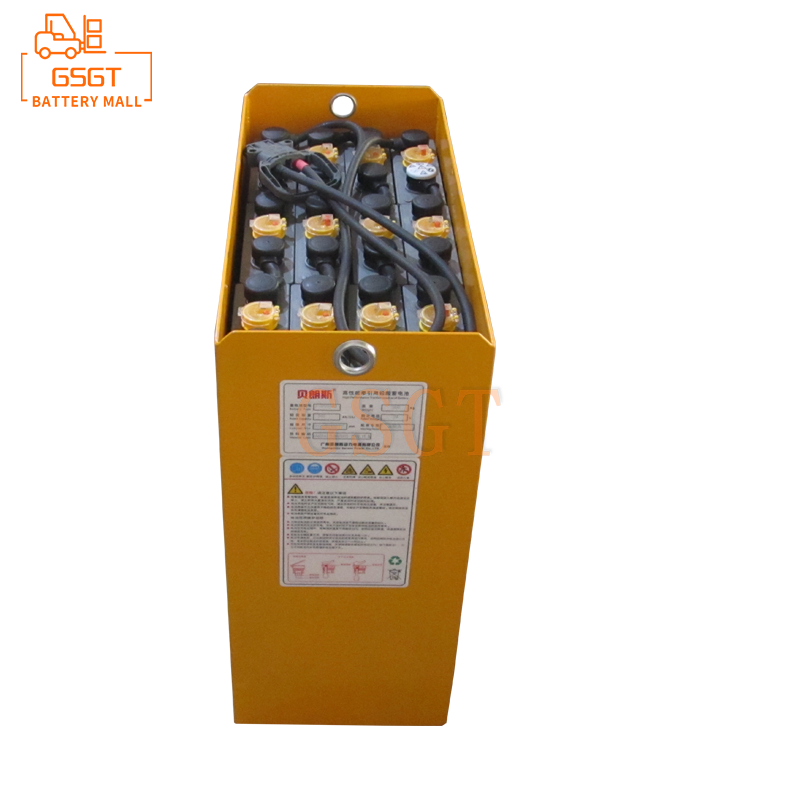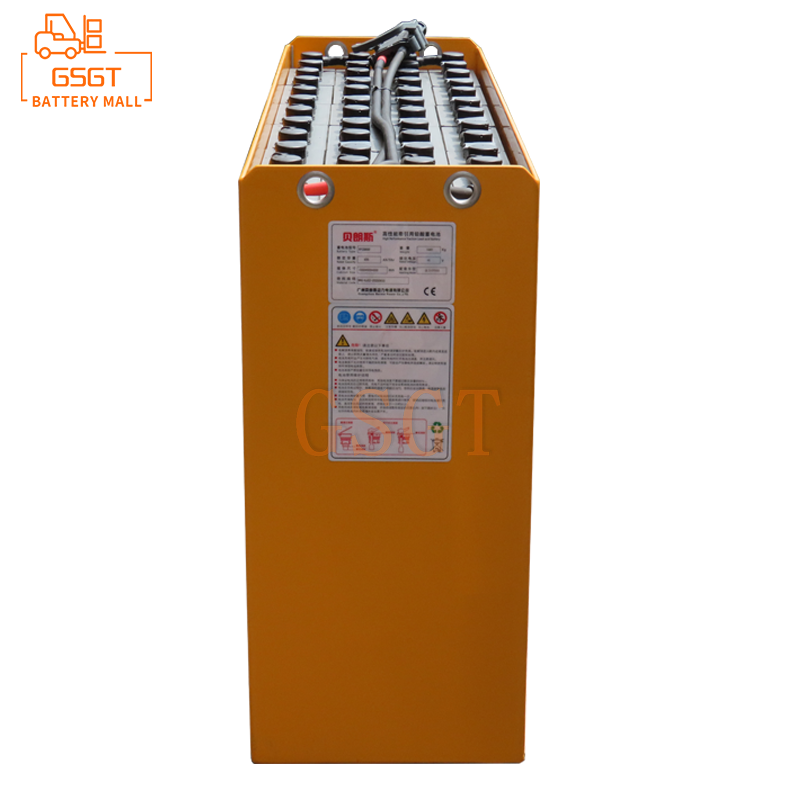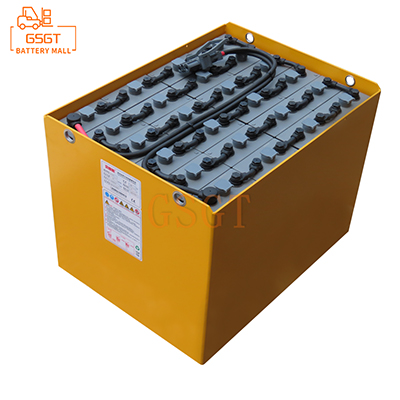Time:2025-04-24 10:09:16
Browse:534
Abstract
This thesis deeply explores the influencing factors of the cycle life of lead-acid batteries in forklifts and proposes practical and feasible improvement strategies for these factors. Through the analysis of the working principle and usage characteristics of forklift lead-acid batteries, combined with actual application scenarios, the key factors affecting the cycle life are analyzed from multiple aspects such as the battery's own characteristics, usage environment, and charge and discharge management. On this basis, a series of improvement strategies including optimizing battery design, improving usage environmental conditions, and reasonable charging and discharging management are proposed, aiming to provide theoretical basis and practical guidance for extending the cycle life of lead-acid batteries in forklifts, reducing usage costs, and improving the operational efficiency of forklifts.
1. Introduction
In the modern logistics and warehousing industry, forklifts, as important handling equipment, play an indispensable role. As the main power source of electric forklifts, the performance and lifespan of lead-acid batteries directly affect the working efficiency and operating costs of forklifts. The cycle life of lead-acid batteries is one of the important indicators to measure their performance. It determines the number of charge and discharge cycles that the battery can undergo under normal usage conditions. With the rapid development of the logistics industry, the requirements for the usage frequency and working hours of forklifts are constantly increasing. Therefore, it is of great practical significance to deeply study the influencing factors of the cycle life of forklift lead-acid batteries and explore effective improvement strategies.
2. Working Principle of Forklift Lead-Acid Batteries
Forklift lead-acid batteries are mainly composed of positive plates, negative plates, electrolyte (sulfuric acid solution) and separators, etc. Its working principle is based on REDOX reactions. During the discharge process, lead dioxide on the positive plate and lead on the negative plate react respectively with sulfuric acid in the electrolyte to form lead sulfate, simultaneously releasing electrical energy to provide power for the forklift. The charging process is the reverse reaction of the discharging process. Under the action of an external power source, lead sulfate is reconverted into lead dioxide and lead, restoring the battery to its energy storage state. This chemical reaction process of charging and discharging is accompanied by changes in the material of the plates and the concentration of the electrolyte, and these changes have a significant impact on the cycle life of the battery.
3. Factors Influencing the Cycle Life of Lead-Acid Batteries in Forklifts
(1) Characteristics of the battery itself
1. **Plate Materials and Manufacturing Processes **
The pl **e the core components of lead-acid batteries, and the quality of their materials and manufacturing processes are crucial to their cycle life. High-quality plate materials should have good electrical conductivity, corrosion resistance and high activity. For instance, using high-purity lead alloy as the plate material can reduce the impact of impurities on battery performance and enhance the plate's resistance to sulfidation. In terms of manufacturing processes, the pasting process and curing process of the plates will affect the bonding strength between the active material and the plates. If the paste is not applied evenly or the curing is insufficient, the active substances are prone to fall off during the charging and discharging process, resulting in a reduction in the effective area of the plates, a decrease in battery capacity, and a shortened cycle life.
2. **Electrolyte Concentration and purity **
The concentration of the electrolyte directly affects the electrochemical rection rate and efficiency of the battery. An appropriate concentration of sulfuric acid helps maintain a good chemical reaction balance. Both excessively high and low concentrations can cause damage to the battery. For instance, an excessively high concentration of the electrolyte will accelerate the corrosion of the plates and reduce their service life. If the concentration is too low, it will lead to insufficient battery capacity. In addition, the impurity content in the electrolyte can also affect the battery performance. Impurities may have adverse reactions with the plates, forming local micro-batteries, accelerating self-discharge, and thereby shortening the battery's cycle life.
(2) Environmental factors of use
1. **Temperature **
Temperature has a significant impact on the performance and cycle life of lead-acid batteries in forklifts. In a low-temperature environment, the viscosity of the electrolyte increases, the ion migration rate slows down, and the internal resistance of the battery increases, resulting in a decrease in charging and discharging efficiency and a decline in battery capacity. Meanwhile, low temperatures will also coarser the lead sulfate crystalline particles on the surface of the plates, increasing the risk of plate sulfation and seriously affecting the cycle life of the battery. In high-temperature environments, the self-discharge rate of batteries increases, the evaporation of the electrolyte intensifies, and the corrosion rate of the plates also speeds up, which in turn shortens the service life of the battery. Generally speaking, the optimal operating temperature range for lead-acid batteries is between 20 and 25 degrees Celsius.
2. **Humidity **
High humidity environments are prone to cause corrosion of battery casings and plates. Moist air will form a thin water film on the surface of the battery. The ions in the water will undergo electrochemical corrosion reactions with the metal components of the battery, damaging the battery's structure, reducing its insulation performance, and thereby affecting the normal operation and cycle life of the battery. In addition, when the humidity is high, it may also cause oxidation and rusting of the battery connection parts, increase contact resistance, and affect the charging and discharging performance of the battery.
(3) Charging and Discharging Management factors
1. **Depth of Charge and discharge **
Charge and discharge depth refers to the percentage of the amount of electricity discharged or charged by a battery during a single charge and discharge process to its rated capacity. Excessive discharge will cause a large amount of lead sulfate to form on the plates. After deep discharge, the lead sulfate crystalline particles will become larger and difficult to be completely converted into active substances in the subsequent charging process, resulting in sulfation of the plates and seriously affecting the cycle life of the battery. On the contrary, overcharging will cause the battery to heat up, accelerate the decomposition of the electrolyte and the corrosion of the plates, and also shorten the battery life. It is generally recommended that the discharge depth of lead-acid batteries in forklifts be controlled at around 80% to avoid excessive charging and discharging.
2. **Charging and Discharging current **
The magnitude of the charging and discharging current directly affects the electrochemical reaction rate and heat generation inside the battery. Excessive charging current can cause severe heating inside the battery, leading to an increase in the temperature of the electrolyte, accelerating the corrosion and aging of the plates. At the same time, it may also cause excessive gas production inside the battery, resulting in battery swelling or even damage. However, a too small charging current will prolong the charging time and reduce the working efficiency. Similarly, excessive discharge current will cause the battery to have an excessive instantaneous output power, leading to the shedding of the active material on the plates and affecting the battery's cycle life.
(4) Maintenance and care factors
1. **Regularly check and replenish the electrolyte **
During the use of lead-acid batteries in forklifts, the electrolyte will gradually decrease due to evaporation and chemical reactions. If an appropriate amount of distilled water or special electrolyte is not replenished in time, the plates will be exposed to the air, causing sulfation and oxidation of the plates, which will seriously affect the performance and cycle life of the battery. In addition, regularly checking the density and liquid level of the electrolyte can help identify potential problems with the battery in a timely manner, and corresponding measures can be taken for adjustment and maintenance.
2. ** Battery cleaning and maintenance of connection parts **
Keeping the battery surface clean can prevent the occurrence of leakage and short circuit on the battery surface. Dust on the battery surface and residual electrolyte can form conductive paths, leading to an increase in battery self-discharge. At the same time, regularly check the tightness and contact conditions of the battery connection parts to prevent loosening and oxidation of the connection parts. Loosening of the connection parts will increase the contact resistance, resulting in heating. Oxidation can reduce electrical conductivity and affect the charging and discharging performance of batteries, all of which have adverse effects on the cycle life of batteries.
4. Strategies for Enhancing the Cycle Life of Lead-Acid Batteries in Forklifts
(1) Optimize battery design
1. **Improve the material and manufacturing process of the plates **
Develop and adopt new lead alloy plate materials, such as adding appropriate amounts of calcium, tin, silver and other elements, to enhance the strength, corrosion resistance and electrical conductivity of the plates. Improve the paste coating process of the plates to ensure that the active substances are evenly coated on the plates, and optimize the curing process to enhance the adhesion between the active substances and the plates and reduce the shedding of the active substances. Through these measures, the cycle life of the battery can be effectively improved.
2. ** Optimize the electrolyte formula **
Research and develop electrolyte formulas that are more suitable for forklift lead-acid batteries, precisely control the concentration of sulfuric acid, and reduce the impurity content in the electrolyte. Some functional additives, such as antioxidants and corrosion inhibitors, can be added to suppress the corrosion and self-discharge of the plates, thereby enhancing the performance and cycle life of the battery. Meanwhile, a sealed electrolyte structure is adopted to reduce the evaporation and leakage of the electrolyte, thereby enhancing the safety and lifespan of the battery.
(2) Improve the environmental conditions for use
1. **Temperature Control **
Equip the lead-acid batteries of forklifts with temperature regulation devices, such as heating and cooling systems. In a low-temperature environment, the battery temperature is raised through a heating device to keep it within an appropriate working temperature range, reducing the internal resistance of the battery and improving the charging and discharging efficiency. In high-temperature environments, the cooling system is utilized to lower the battery temperature, reducing plate corrosion and self-discharge. In addition, in usage sites such as warehouses or workshops, the parking positions of forklifts should be reasonably planned to prevent batteries from being exposed to extreme temperature environments for a long time.
2. **Humidity Control **
Keep the storage and usage environment of the battery dry, install dehumidification equipment, and control the environmental humidity within an appropriate range. For forklifts operating in a humid environment, protective treatment can be carried out on the battery, such as using a waterproof casing or sealing gasket to prevent moisture from entering the battery interior. Regularly dry the battery to remove moisture from its surface and reduce the risk of corrosion.
(3) Reasonable charging and discharging management
1. **Control the depth of charging and discharging **
In the operation and management of forklifts, it is necessary to formulate reasonable charging and discharging rules to avoid excessive charging and discharging. By installing a battery management system, the battery's power level and charging and discharging status can be monitored in real time. When the battery power reaches the set discharge depth, it will promptly remind the operator to charge it. Meanwhile, during the charging process, when the battery is fully charged, it will automatically stop charging to prevent overcharging.
2. ** Optimize charging and discharging currents **
Select the appropriate charging and discharging current based on the capacity and performance characteristics of the battery. In the early stage of charging, a larger current can be adopted for fast charging to improve the charging efficiency. In the later stage of charging, a smaller current is used for trickle charging to ensure the battery is fully charged and to avoid overheating and overcharging. During the discharge process, limit the maximum output power of the forklift to prevent excessive discharge current from damaging the battery. In addition, by adopting intelligent charging and discharging equipment, the charging and discharging current can be automatically adjusted according to the actual state of the battery, further optimizing the charging and discharging process.
(4) Strengthen maintenance and upkeep
1. **Establish a regular maintenance system **
Formulate a detailed regular maintenance plan for forklift lead-acid batteries, including regular checks of the electrolyte level and density, cleaning of the battery surface, and inspection of connection parts, etc. Regularly maintain and service the battery as planned, and promptly identify and solve any problems existing in the battery. For instance, check the electrolyte level once a week, the electrolyte density once a month, and clean and tighten the battery connection parts once every quarter.
2. **Professional Personnel Training and Management **
Provide professional training for forklift operators and battery maintenance personnel to enable them to master the working principle, usage methods and maintenance skills of batteries. The training content includes correct charging and discharging operations, battery inspection methods, common fault diagnosis and handling, etc. By enhancing the professional quality of personnel, the use and maintenance of batteries can be better carried out, and the cycle life of batteries can be prolonged. At the same time, a complete battery maintenance management file should be established to record the battery's usage, maintenance content, and fault handling, etc., so as to track and analyze the battery's lifespan and provide references for subsequent maintenance and management.
5. Conclusion
The cycle life of forklift lead-acid batteries is comprehensively influenced by various factors such as the battery's own characteristics, usage environment, charging and discharging management, and maintenance. Through in-depth analysis of these influencing factors, we can adopt targeted improvement strategies, such as optimizing battery design, improving usage environmental conditions, rationally managing charging and discharging, and strengthening maintenance and upkeep. The implementation of these strategies can effectively extend the cycle life of lead-acid batteries in forklifts, reduce the operating costs of logistics and warehousing enterprises, and improve the operational efficiency and reliability of forklifts. In the future, with the continuous development of technology, it is still necessary to further explore new technologies and methods to constantly improve the performance and lifespan of lead-acid batteries and meet the growing demands of the logistics industry. At the same time, attention should also be paid to the development of new battery technologies to provide more options for the upgrade of forklift power systems.
The above article has conducted an in-depth analysis of the issues related to the cycle life of forklift lead-acid batteries from multiple dimensions and proposed solutions. It has high reference value and originality. We hope it will be helpful to you.

$1105

$3810

$3405

$2140

MESSAGE
Professional And Efficient
Security
Affordable Price
Professional Services